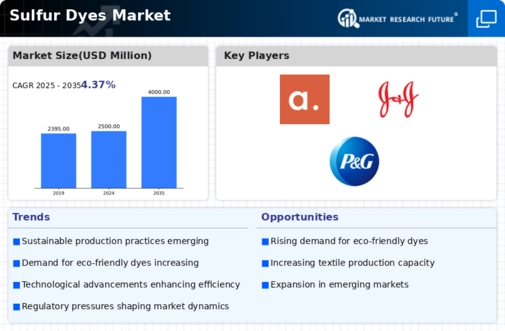Sulfur Dyes Size
Sulfur Dyes Market Growth Projections and Opportunities
The Sulfur Dyes Market is influenced by a variety of factors that collectively shape its trends and growth patterns. One of the primary drivers is the demand from the textile industry, where sulfur dyes play a crucial role in coloring fabrics such as cotton, rayon, and linen. The textile sector's growth, driven by consumer preferences for vibrant and long-lasting colors, contributes significantly to the demand for sulfur dyes in the dyeing and finishing processes.
Global economic conditions play a pivotal role in the Sulfur Dyes Market. Economic growth and industrialization contribute to increased textile manufacturing activities, thereby boosting the demand for sulfur dyes. Developing economies, in particular, witness a surge in textile production as they become major players in the global textile market, further propelling the market for sulfur dyes.
The environmental friendliness of sulfur dyes is a notable factor influencing the market. As sustainability becomes a key consideration in various industries, including textiles, sulfur dyes gain prominence due to their lower environmental impact compared to certain other dye types. The absence of heavy metals in sulfur dyes aligns with stringent environmental regulations and the growing trend of eco-friendly manufacturing practices.
Technological advancements in dyeing processes and formulations impact the Sulfur Dyes Market. Ongoing research and development efforts lead to innovations that enhance the efficiency, colorfastness, and overall performance of sulfur dyes. Companies investing in these technological advancements gain a competitive edge by offering high-quality and versatile dyeing solutions that meet the evolving needs of the textile industry.
The fashion and apparel industry significantly contribute to the Sulfur Dyes Market. As consumer trends and fashion preferences drive the demand for a wide range of colors and styles, sulfur dyes provide an economical and effective solution for achieving vibrant and diverse color palettes in textiles. The constant evolution of fashion and the demand for unique and customizable products fuel the adoption of sulfur dyes.
Geopolitical factors and trade dynamics also play a role in shaping the Sulfur Dyes Market. Fluctuations in trade relations, changes in tariffs, and geopolitical tensions can impact the supply chain and pricing of sulfur dyes. Companies need to stay informed about global trade developments and adjust their strategies to navigate potential risks and capitalize on emerging opportunities in the global market.
Moreover, the growth of the home textile industry contributes to the demand for sulfur dyes. As home furnishings and interior décor become integral aspects of consumer lifestyle choices, the use of sulfur dyes in coloring materials like curtains, bed linens, and upholstery fabric becomes prevalent. The desire for aesthetically pleasing and customizable home textiles further drives the market for sulfur dyes.
Raw material prices, particularly those of sulfur and related compounds, play a role in shaping the Sulfur Dyes Market. Fluctuations in the costs of raw materials impact the production costs and pricing of sulfur dyes. Companies in the market must implement effective supply chain strategies and cost management practices to navigate these raw material price dynamics.







Leave a Comment